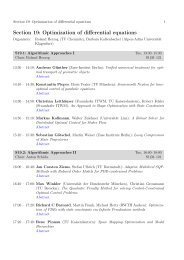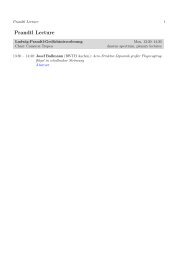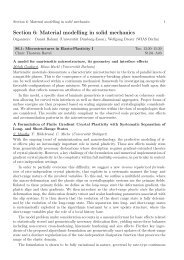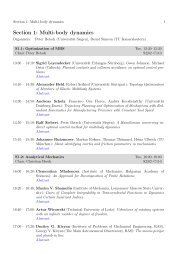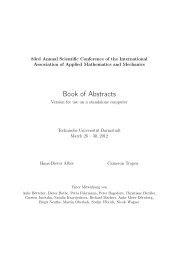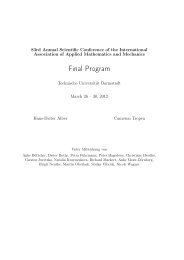Section 23: Applied operator theory - GAMM 2012
Section 23: Applied operator theory - GAMM 2012
Section 23: Applied operator theory - GAMM 2012
You also want an ePaper? Increase the reach of your titles
YUMPU automatically turns print PDFs into web optimized ePapers that Google loves.
<strong>Section</strong> <strong>23</strong>: <strong>Applied</strong> <strong>operator</strong> <strong>theory</strong> 1<br />
<strong>Section</strong> <strong>23</strong>: <strong>Applied</strong> <strong>operator</strong> <strong>theory</strong><br />
Organizers: Jussi Behrndt (TU Graz), Carsten Trunk (TU Ilmenau)<br />
S<strong>23</strong>.1: Spectral Theory in Hilbert and Krein Spaces Tue, 13:30–15:30<br />
Chair: Carsten Trunk S1|03–107<br />
Dirac-Krein <strong>operator</strong>s on star graphs<br />
Vadim Adamyan (Odessa National I.I. Mechnikov University)<br />
The talk focuses on the description of the spectrum of a self-adjoint Dirac-Krein differential<br />
<strong>operator</strong><br />
<br />
0<br />
H = −<br />
1<br />
<br />
−1 d<br />
0 dx +<br />
<br />
p(x)<br />
q(x)<br />
<br />
q(x)<br />
,<br />
−p(x)<br />
on an n-pointed compact star graph Γ, where p(x), q(x) are continuous real-valued functions on<br />
the edges of Γ. The <strong>operator</strong> H is considered as a perturbation of the orthogonal sum H(12) of the<br />
self-adjoint Dirac-Krein <strong>operator</strong>s on the disjoint edges of Γ, defined on two-component vector<br />
functions with zero first component at one end point and zero second component at the other<br />
end point of each edge of Γ; the domain of H is assumed to consist of all vector functions the<br />
first components of which coincide at the unique vertex of the star graph where all edges touch,<br />
while the boundary conditions at the pendent ends of all edges are the same as for H(12). As a<br />
main tool we use Krein’s resolvent formula for the resolvent kernels (Green’s functions) of H(12)<br />
and H. We prove that the set of common eigenvalues of H and H(12) coincides with the set of<br />
multiple eigenvalues of H(12), but their multiplicities as eigenvalues of H decreases by one. We<br />
also prove that the sets of simple eigenvalues of H and the set of all eigenvalues of H(12) interlace.<br />
The asymptotic behaviour of the number of eigenvalues of H, multiplicities taken into account,<br />
on spectral intervals (−Λ, 0) and (0, Λ) as Λ → ∞ is derived.<br />
The talk is based on a joint work with Heinz Langer and Christiane Tretter.<br />
Spectral functions of products of selfadjoint <strong>operator</strong>s<br />
Tomas Ya. Azizov, Mikhail Denisov (Voronezh State University), Friedrich Philipp (TU Berlin)<br />
Given two possibly unbounded selfadjoint <strong>operator</strong>s A and G such that the resolvent sets of AG<br />
and GA are non-empty, it is shown that the <strong>operator</strong> AG has a spectral function on R with<br />
singularities if there exists a polynomial p = 0 such that the symmetric <strong>operator</strong> Gp(AG) is<br />
non-negative. We apply this result to weighted Sturm-Liouville problems.<br />
Variation of discrete spectra of non-negative <strong>operator</strong>s in Krein spaces<br />
Jussi Behrndt (TU Graz), Leslie Leben (TU Ilmenau), Friedrich Philipp (TU Berlin)<br />
Considered is an additive perturbation of a bounded non-negative <strong>operator</strong> A in a Krein space<br />
with a likewise bounded non-negative <strong>operator</strong> C from a Schatten-von Neumann ideal of order<br />
p, such that ker C = ker C 2 and 0 is not a singular critical point of C. We show a qualitative<br />
result on the variation of the discrete spectra of the unperturbed and perturbed <strong>operator</strong>, that<br />
is, given a finite union ∆ of open intervals with 0 /∈ ∆, there exist enumerations (αn) and (βn) of<br />
the discrete eigenvalues of A and B := A + C in ∆ such that<br />
(βn − αn) ∈ ℓ p .<br />
Sign preserving Perturbations of Eigenvalues<br />
Roland Möws (TU Ilmenau), Jussi Behrndt (TU Graz), Carsten Trunk (TU Ilmenau)
2 <strong>Section</strong> <strong>23</strong>: <strong>Applied</strong> <strong>operator</strong> <strong>theory</strong><br />
We consider two <strong>operator</strong>s A and B which are self-adjoint in a Krein space (K, [·, ·]) and whose<br />
resolvent difference is one-dimensional, i.e.<br />
dim ran (A − λ) −1 − (B − λ) −1 = 1, λ ∈ ρ(A) ∩ ρ(B).<br />
It is well-known that the algebraic eigenspace corresponding to a real discrete eigenvalue of A<br />
(or B), equipped with [·, ·], is a Krein space. The main result is the following: Assume that there<br />
exists a domain Ω ⊂ C in which A (or, equivalently, B) has similar spectral properties as a<br />
definitizable <strong>operator</strong> and that A satisfies a certain minimality condition. Moreover, let λ1 and λ2<br />
be two discrete eigenvalues of A in Ω ∩ R such that (λ1, λ2) ⊂ ρ(A) and [·, ·] is positive definite on<br />
both ker(A−λ1) and ker(A−λ2). Then there exists a (discrete) eigenvalue µ of B in (λ1, λ2) such<br />
that [·, ·] is not negative definite on the algebraic eigenspace corresponding to µ. In particular, if<br />
µ is a simple eigenvalue with a corresponding eigenvector f, then [f, f] > 0.<br />
The result is applied to a class of Sturm-Liouville problems with an indefinite weight function.<br />
Zeros of Nevanlinna functions with one negative square<br />
Henrik Winkler (TU Ilmenau)<br />
A generalized Nevanlinna function Q(z) with one negative square has precisely one generalized<br />
zero of nonpositive type in the closed extended upper halfplane. The fractional linear transformation<br />
defined by Qτ(z) = (Q(z) − τ)/(1 + τQ(z)), τ ∈ R ∪ {∞}, is a generalized Nevanlinna<br />
function with one negative square. Its generalized zero of nonpositive type α(τ) as a function of τ<br />
defines a path in the closed upper halfplane. Various properties of this path are studied in detail.<br />
A perturbation approach to differential <strong>operator</strong>s with indefinite weights<br />
Jussi Behrndt (TU Graz), Friedrich Philipp (TU Berlin), Carsten Trunk (TU Ilmenau)<br />
In many situations differential <strong>operator</strong>s with indefinite weight functions can be regarded as perturbations<br />
of nonnegative selfadjoint <strong>operator</strong>s in Krein spaces. In this talk we first provide an<br />
abstract result on bounded additive perturbations and apply it afterwards to Sturm-Liouville and<br />
second order elliptic partial differential <strong>operator</strong>s with indefinite weights on unbounded domains.<br />
S<strong>23</strong>.2: Partial Differential Operators Tue, 16:00–18:00<br />
Chair: Sergey Belyi S1|03–107<br />
Weak Neumann implies Stokes<br />
Horst Heck (TU Darmstadt)<br />
When studying the Navier-Stokes equations, one of the basic models in fluid dynamics, a thorough<br />
understanding of the (linear) Stokes equation is very helpful. In particular, the property<br />
of maximal L p -regularity is a very powerful tool in order to treat the nonlinear equation. In this<br />
presentation we show that the existence of the Helmholtz projection in L q (Ω) is sufficient for the<br />
maximal L p -regularity of the Stokes <strong>operator</strong>, provided the domain Ω ⊂ R n is smooth enough.<br />
The presented result is a joint work with M. Geissert, M. Hieber, and O. Sawada.<br />
Schrödinger <strong>operator</strong>s with interactions on hypersurfaces<br />
Vladimir Lotoreichik (TU Graz)<br />
In the talk we plan to present a new approach to the definition of self-adjoint Schrödinger <strong>operator</strong>s<br />
with δ and δ ′ interactions on hypersurfaces. This approach uses <strong>operator</strong> extension <strong>theory</strong> via quasi
<strong>Section</strong> <strong>23</strong>: <strong>Applied</strong> <strong>operator</strong> <strong>theory</strong> 3<br />
boundary triples. Within our approach we prove results concerning spectral and scattering <strong>theory</strong><br />
of Schrödinger <strong>operator</strong>s with interactions on hypersurfaces.<br />
A comparison with the approach based on quadratic forms will be given. The quadratic form<br />
for δ ′ interactions was not constructed so far and the question of its construction was posed as<br />
an open problem by Pavel Exner in 2008. In the talk it will be also presented our solution of that<br />
problem.<br />
The talk is based on a joint work with Jussi Behrndt (Graz University of Technology) and<br />
Matthias Langer (University Strathclyde).<br />
Spectra of selfadjoint elliptic differential <strong>operator</strong>s, Robin-to-Dirichlet maps, and an<br />
inverse problem of Calderón type<br />
Jussi Behrndt, Jonathan Rohleder (TU Graz)<br />
In this talk we consider selfadjoint <strong>operator</strong> realizations of an elliptic differential expression of the<br />
form<br />
n ∂ ∂<br />
Lu = − ajk u + au<br />
∂xj ∂xk<br />
j,k=1<br />
on a bounded or unbounded domain Ω with certain local or nonlocal Robin type boundary conditions.<br />
We will discuss the connections between the behaviour of a corresponding Robin-to-Dirichlet<br />
maps on the boundary of Ω at its discontinuities and the point, absolutely continuous, and singular<br />
continuous spectra of the <strong>operator</strong> realization. As an application, we present a mild uniqueness<br />
result for the Calderón or Gelfand inverse problem corresponding to L.<br />
Selfadjoint elliptic differential <strong>operator</strong>s on domains with non-compact boundary<br />
Christian Kühn (TU Berlin)<br />
We consider a uniformly elliptic differential expression L of second order on an open set Ω in R n<br />
with a non-compact boundary. We show selfadjointness of a class of realizations of L in L 2 (Ω).<br />
The talk is based on a joint work with J. Behrndt.<br />
Extensible quasi boundary triples and applications<br />
Till Micheler (TU Berlin), Jussi Behrndt (TU Graz)<br />
We study extensions of symmetric <strong>operator</strong>s in Hilbert spaces via a generalization of boundary<br />
triple methods and also discuss applications to elliptic partial differential <strong>operator</strong>s on smooth<br />
and rough domains.<br />
S<strong>23</strong>.3: <strong>Applied</strong> Operator Theory and Linear Systems Wed, 13:30–15:30<br />
Chair: Andras Batkai S1|03–107<br />
The Elusive Drude-Born-Fedorov Model for Chiral Electromagnetic Media.<br />
Rainer Picard, Henrik Freymond (TU Dresden)<br />
In a Hilbert space <strong>operator</strong> setting, covering a comprehensive class of evolutionary equations, as<br />
a particular application various aspects of material laws for Maxwell’s equations are discussed.<br />
In particular, the Drude-Born-Fedorov model for electromagnetic waves in chiral media is investigated<br />
and well-posedness is shown.<br />
Well-posedness and conservativity for linear control systems (Part 1)<br />
Marcus Waurick (TU Dresden)
4 <strong>Section</strong> <strong>23</strong>: <strong>Applied</strong> <strong>operator</strong> <strong>theory</strong><br />
We discuss a class of linear control problems in a Hilbert space setting. The aim is to show that<br />
these control problems fit in a particular class of evolutionary equations such that the discussion<br />
of well-posedness becomes easily accessible. We exemplify our findings by a system with unbounded<br />
control and observation <strong>operator</strong>.<br />
Well-posedness and conservativity for linear control systems (Part 2)<br />
Sascha Trostorff (TU Dresden)<br />
Using the results obtained in part 1 of the talk, we study conservativity of a certain class of linear<br />
control problems. For this purpose we require additional regularity properties of our solution<br />
<strong>operator</strong> in order to allow pointwise evaluations of our solution. We apply the results to the linear<br />
control system with unbounded observation and control <strong>operator</strong>s mentioned in the first part of<br />
the talk.<br />
On energy conditions for electromagnetic diffraction by apertures<br />
Matthias Kunik (Universität Magdeburg), Norbert Gorenflo (TFH Berlin)<br />
The diffraction of light is considered for a plane screen with an open bounded aperture. The<br />
corresponding solution behind the screen is given explicitly in terms of the Fourier transforms<br />
of the tangential components of the electric boundary field on the screen. All components of the<br />
electric as well as the magnetic field vector are considered. We introduce solutions with global<br />
finite energy behind the screen and describe them in terms of two boundary potential functions.<br />
This new approach leads to a decoupling of the vectorial boundary equations on the screen in the<br />
case of global finite energy. For the physically admissible solutions, i.e. the solutions with local<br />
finite energy, we derive a characterisation in terms of the electric boundary fields.<br />
Approximation methods for a class of perturbed paired convolution equations<br />
Michał A. Nowak (AGH University of Science and Technology, Krakow)<br />
We consider approximation methods for some class of perturbed paired convolution equations (or,<br />
in general, singular equations). Effective error estimates, and simultaneously, decaying properties<br />
for solutions are obtained in terms of some smooth spaces. The talk is based on a joint work with<br />
Petru A. Cojuhari.<br />
Hamiltonians and Riccati equations for unbounded control and observation <strong>operator</strong>s<br />
Christian Wyss, Birgit Jacob (Universität Wuppertal), Hans Zwart (University of Twente, The<br />
Netherlands)<br />
We consider the control algebraic Riccati equation<br />
A ∗ X + XA − XBB ∗ X + C ∗ C = 0<br />
for the case that A is normal with compact resolvent, B ∈ L(U, H−s) and C ∈ L(Hs, Y ), 0 ≤ s ≤ 1.<br />
Here Hs ⊂ H ⊂ H−s are the usual fractional domain spaces corresponding to A. Under certain<br />
additional assumptions on A, B and C we show the existence of infinitely many solutions X of<br />
the Riccati equation using invariant subspaces of the Hamiltonian <strong>operator</strong> matrix<br />
<br />
∗<br />
A −BB<br />
T =<br />
.<br />
−C ∗ C −A ∗<br />
The first problem is here to make sense of T as an <strong>operator</strong> on H × H, because BB ∗ and C ∗ C<br />
map from Hs to H−s. Our main tools are then Riesz bases of eigenvectors of T and indefinite<br />
inner products. In general the solutions X will be unbounded, but we also obtain conditions for<br />
bounded solutions.
<strong>Section</strong> <strong>23</strong>: <strong>Applied</strong> <strong>operator</strong> <strong>theory</strong> 5<br />
S<strong>23</strong>.4: <strong>Applied</strong> Operator Theory Wed, 16:00–18:00<br />
Chair: Jussi Behrndt S1|03–107<br />
Shape Preservation of Evolution Equations<br />
András Bátkai (Loránd Eötvös University Budapest)<br />
Motivated by positivity-, monotonicity-, and convexity preserving differential equations, we introduce<br />
a definition of shape preserving <strong>operator</strong> semigroups and analyze their fundamental properties.<br />
In particular, we prove that the class of shape preserving semigroups is preserved by<br />
perturbations and taking limits. These results are applied, among others, to partial delay differential<br />
equations.<br />
Sectorial realizations of Stieltjes functions<br />
Sergey Belyi (Troy University)<br />
A class of Stieltjes functions with a special condition is considered. We show that a function<br />
belonging to this class can be realized as the impedance function of a singular L-system with<br />
a sectorial state-space <strong>operator</strong>. We provide an additional condition on a given function from<br />
this class so that the state-space <strong>operator</strong> of the realizing L-system is α-sectorial with the exact<br />
angle of sectoriality α. Then these results are applied to L-systems based upon a non-self-adjoint<br />
Schrödinger <strong>operator</strong>.<br />
The talk is based on a joint work with Yu. Arlinskiĭ and E. Tsekanovskiĭ.<br />
On trace norm estimates<br />
Johannes Brasche (TU Clausthal)<br />
Let E and P be nonnegative quadratic forms in a Hilbert space H and suppose that E and the<br />
sum E + bP is densely defined and closed for every b > 0. Let Hb be the selfadjoint <strong>operator</strong><br />
associated to E + bP . We present estimates for the trace norm of<br />
(Hb + 1) −1 − lim<br />
b ′ (Hb ′ + 1)−1<br />
−→∞<br />
In particular, we present a criterion in order that these trace norms tend to zero with maximal<br />
rate, i.e. as fast as O(1/b). We illustrate our results with the aid of point interaction Hamiltonians.<br />
On determining the domain of the adjoint <strong>operator</strong><br />
Michal Wojtylak (Jagiellonian University, Cracow)<br />
A theorem that is of aid in computing the domain of the adjoint <strong>operator</strong> will be presented. It may<br />
serve e.g. as a criterion for selfadjointness of a symmetric <strong>operator</strong>, for normality of a formally<br />
normal <strong>operator</strong> or for H–selfadjointness of an H–symmetric <strong>operator</strong>.<br />
Parabolic Variational and Quasi-Variational Inequalities with Gradient Constraints<br />
Carlos N. Rautenberg (Universität Graz), Michael Hintermüller (HU Berlin)<br />
A class of nonlinear parabolic quasi-variational inequality (QVI) problems with gradient type<br />
constraints in function space is considered. Problems of this type arise, for instance, in the mathematical<br />
modelization of superconductors and elasto-plasticity. The paper addresses existence,<br />
regularity and approximation results based on monotone <strong>operator</strong> <strong>theory</strong>, Mosco convergence and<br />
C0 semigroup methods. Numerical tests involving the p-Laplacian <strong>operator</strong> with several nonlinear<br />
constraints are provided.
6 <strong>Section</strong> <strong>23</strong>: <strong>Applied</strong> <strong>operator</strong> <strong>theory</strong><br />
On a class of quadratic <strong>operator</strong> pencils with normal coefficients<br />
Friedrich Philipp (TU Ilmenau), Vladimir Strauss (Universidad Simón Bolívar, Caracas),<br />
Carsten Trunk (TU Ilmenau)<br />
A standard description of damped small oscillations of a continuum or of small oscillations of a<br />
pipe carrying steady-state fluid is done via<br />
T ¨z + R ˙z + V z = 0, (1)<br />
where z is a function with values in a Hilbert space and V and R are unbounded <strong>operator</strong>s. A<br />
classical approach is to investigate solutions of the form u(t) = e tλ φ0, and to transform, under<br />
some additional assumptions, the equation in (1) into<br />
L(λ)φ0 := (λ 2 I + λE + F )φ0 = 0<br />
with bounded <strong>operator</strong>s E and F . We will investigate the <strong>operator</strong> polynomial L with the coefficients<br />
E = AC and F = C 2 , where C is a bounded normal <strong>operator</strong> in a Hilbert space H and A<br />
is a bounded selfadjoint <strong>operator</strong> which commutes with C. If there exists a bounded <strong>operator</strong> Z1<br />
which is an <strong>operator</strong> root, i.e., a solution of<br />
Z 2 + ACZ + C 2 = 0,<br />
then L(λ) = λ 2 + λAC + C 2 decomposes into linear factors<br />
L(λ) = (λI − Z1)(λI − Z1),<br />
where Z1 = −AC − Z1.<br />
In our talk we will give sufficient conditions for the existence of an <strong>operator</strong> root. For this we<br />
will investigate the companion <strong>operator</strong> (or linearizer) of the <strong>operator</strong> polynomial L which turns<br />
out to be a normal <strong>operator</strong> in some Krein space. We will then apply recent results from the<br />
spectral <strong>theory</strong> of normal <strong>operator</strong>s in Krein spaces.



